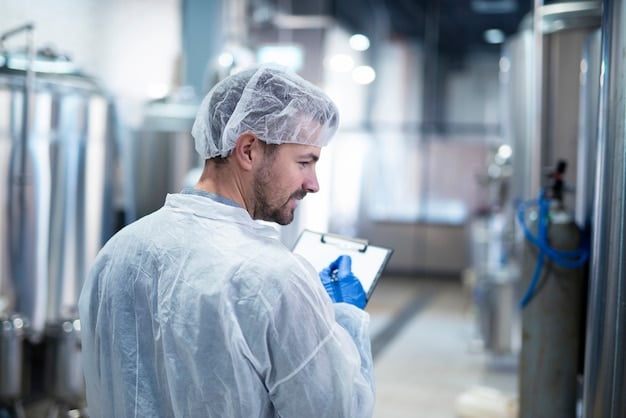US Food Safety Regulations: Key Changes & Impact on Producers

US food safety regulations are undergoing key changes, primarily driven by the Food Safety Modernization Act (FSMA), impacting producers through increased compliance requirements, enhanced traceability, and a shift towards preventative measures.
Navigating the complex landscape of US food safety regulations is crucial for producers. Recent changes, largely influenced by the Food Safety Modernization Act (FSMA), are reshaping how food safety is managed, emphasizing prevention over reaction, and significantly affecting producers.
Understanding the Core of US Food Safety Regulations
The foundation of food safety in the US rests upon a complex framework of laws, regulations, and agencies working together. Understanding this is essential for any producer aiming to comply and thrive in the market.
This network is designed to prevent foodborne illnesses and ensure that the food supply is safe for consumption. The key players and legislations are vital to understand.
Key Agencies and Their Roles
Several agencies play critical roles in overseeing food safety, each with distinct responsibilities. It’s important to know who is setting the standards and conducting the enforcement.
- Food and Drug Administration (FDA): Oversees the safety of most food products, including seafood and produce. They enforce regulations and inspect facilities to ensure compliance.
- United States Department of Agriculture (USDA): Responsible for the safety of meat, poultry, and processed egg products. They also conduct inspections and enforce regulations.
- Environmental Protection Agency (EPA): Sets standards for pesticide use and monitors environmental contaminants in food.

These agencies collaborate to create a multi-layered approach to food safety, from farm to table.
The Food Safety Modernization Act (FSMA): A Paradigm Shift
The FSMA represents a landmark shift in US food safety regulations, moving from reactive responses to proactive prevention. This act aims to prevent foodborne illnesses before they occur, rather than reacting after outbreaks.
Understanding the key principles and requirements of FSMA is essential for producers to ensure compliance and maintain a safe food supply.
Key Principles of FSMA
Several core principles underpin FSMA, guiding the preventive and proactive approach to food safety.
- Prevention: Emphasizes preventing food safety problems rather than reacting to them.
- Science-based standards: Requires that food safety standards be based on scientific evidence and risk assessments.
- Accountability: Holds food producers accountable for implementing preventive controls and ensuring the safety of their products.
The FSMA impacts various aspects of food production, requiring producers to implement comprehensive food safety plans.
Major Changes Introduced by FSMA and Their Implications
FSMA introduces several significant changes to US food safety regulations, each with direct implications for producers. Changes require a shift in practices and thinking.
These changes aim to strengthen the food safety system and reduce the risk of foodborne illnesses.
Preventive Controls for Human Food Rule
This rule requires food facilities to implement preventive controls to minimize or prevent food safety hazards. It is a cornerstone of FSMA.
The rule requires facilities to conduct hazard analyses and implement preventive controls such as sanitation procedures, allergen controls, and supply-chain controls.
Produce Safety Rule
This rule sets standards for the safe production and harvesting of fruits and vegetables. It is aimed at reducing the risk of contamination in the field.
It addresses areas such as agricultural water, worker hygiene, soil amendments, and wild and domesticated animals.
Impact on Different Types of Food Producers
The impact of FSMA varies depending on the type and size of food production operation. Some producers are affected more directly than others.
Understanding these variations is crucial for tailoring compliance strategies to specific needs.
Small and Medium-sized Farms
Small and medium-sized farms may face unique challenges in complying with FSMA due to limited resources and infrastructure. It’s important to explore options to make things work with less.
- Compliance costs: Implementing new safety measures can be expensive, especially for smaller operations.
- Technical expertise: Understanding and implementing complex regulations may require expertise that smaller farms lack.
- Training and education: Providing adequate training to employees on food safety practices is essential but can be challenging.
There are resources available to help small and medium-sized farms navigate the complexities of FSMA compliance.

Strategies for Producers to Adapt and Comply
Adapting to the new food safety landscape requires producers to take proactive steps to ensure compliance. A plan can make a big difference.
Strategic planning, investment in technology, and employee training are all critical components of a successful adaptation strategy.
Developing a Comprehensive Food Safety Plan
A well-designed food safety plan is essential for demonstrating compliance with FSMA and protecting public health. It’s the core of meeting the regulations.
- Hazard analysis: Identifying potential food safety hazards and assessing the risk they pose.
- Preventive controls: Implementing measures to minimize or prevent identified hazards.
- Monitoring and verification: Regularly monitoring the effectiveness of preventive controls and verifying that they are working as intended.
The Future of Food Safety Regulations in the US
The future of food safety regulations in the US is likely to be shaped by several factors, including technological advancements, changing consumer preferences, and emerging food safety risks. Regulations are always in motion.
Staying informed about these trends and developments will be essential for producers to maintain compliance and ensure the safety of their products.
Embracing Technological Innovations
Technology is playing an increasingly important role in food safety, from advanced monitoring systems to blockchain technology for traceability. Technology is changing the field rapidly.
- Real-time monitoring sensors: Track temperature, humidity, and other critical parameters to ensure food safety throughout the supply chain.
- Blockchain technology: Enables secure and transparent tracking of food products from farm to table.
- Data analytics: Analyzes large datasets to identify trends and potential food safety risks.
By embracing these innovations, producers can enhance their food safety practices and meet the evolving expectations of consumers and regulators. Understanding US food safety regulations is a continuous process.
| Key Point | Brief Description |
|---|---|
| 🛡️ FSMA Overview | The Food Safety Modernization Act shifts focus to preventing foodborne illnesses proactively. |
| 🥕 Produce Safety Rule | Sets standards for safe fruit and vegetable production, addressing water quality, hygiene, and more. |
| 🔬 Preventive Controls | Requires food facilities to implement preventive measures to minimize food safety hazards. |
| 🌱 Farm Adaptation | Strategies for farms to comply, including safety plans, tech adoption, and employee training. |
Frequently Asked Questions
▼
The primary goal of FSMA is to shift the focus from responding to foodborne illnesses to preventing them from occurring in the first place. It aims to ensure the US food supply is safe by implementing preventive controls.
▼
The Produce Safety Rule sets national standards for the safe growing, harvesting, packing, and holding of fruits and vegetables for human consumption. It addresses water, hygiene, and animal-related risks.
▼
Preventive controls are risk-based, reasonably appropriate procedures, practices, and processes that food facilities implement to minimize or prevent food safety hazards. They are crucial for complying with FSMA regulations.
▼
The FDA, USDA, and various extension programs offer guidance, training, and technical assistance to help small farms understand and comply with FSMA regulations. Local and regional workshops are also available.
▼
Technology, such as real-time monitoring sensors, blockchain for traceability, and data analytics, helps producers track, monitor, and analyze food safety data. This enhances their ability to prevent and address food safety risks.
Conclusion
Adapting to the evolving landscape of US food safety regulations, especially with FSMA, requires producers to embrace proactive and preventive strategies. By staying informed, implementing robust food safety plans, and leveraging technological innovations, producers can ensure compliance, protect public health, and maintain consumer trust in the food supply.





